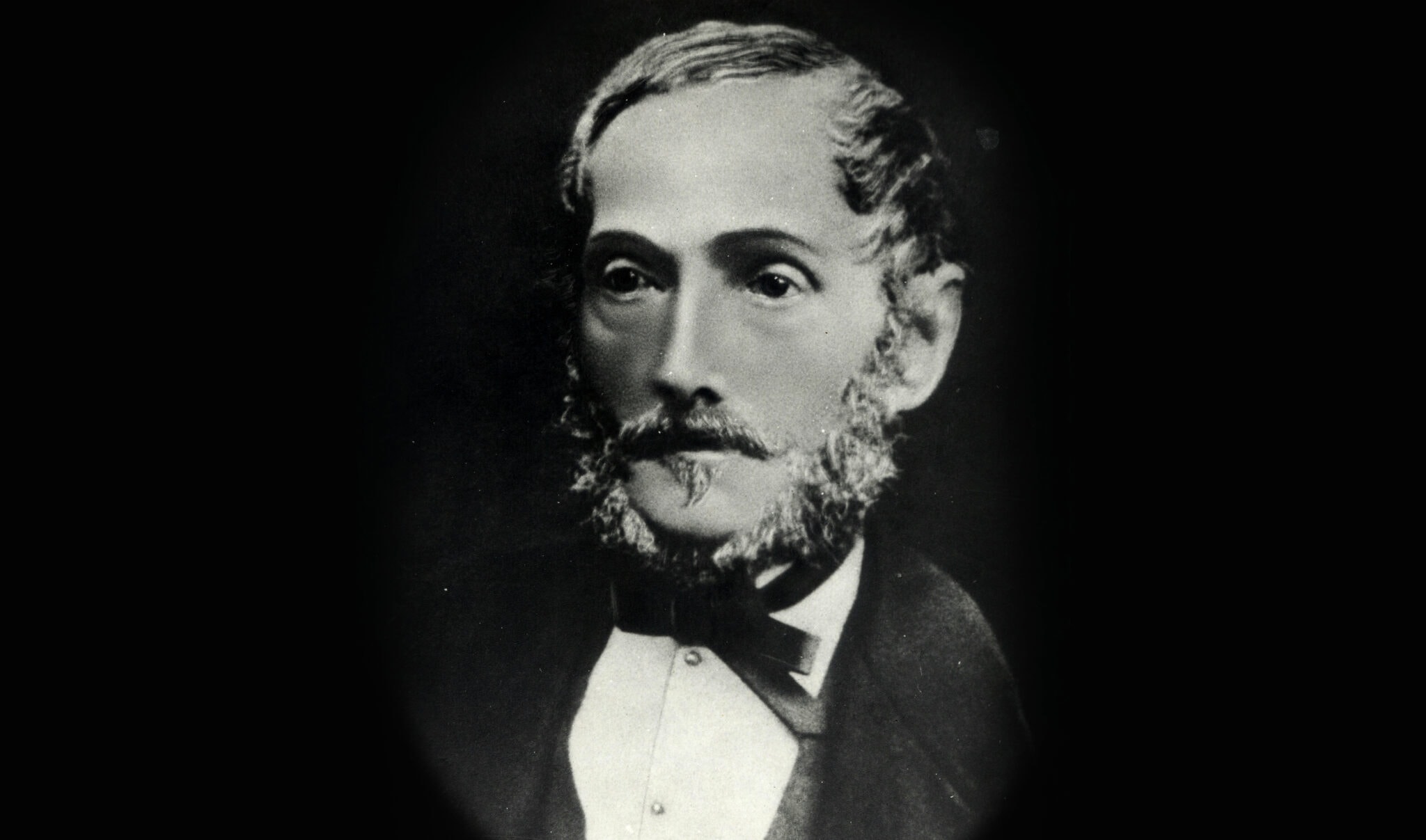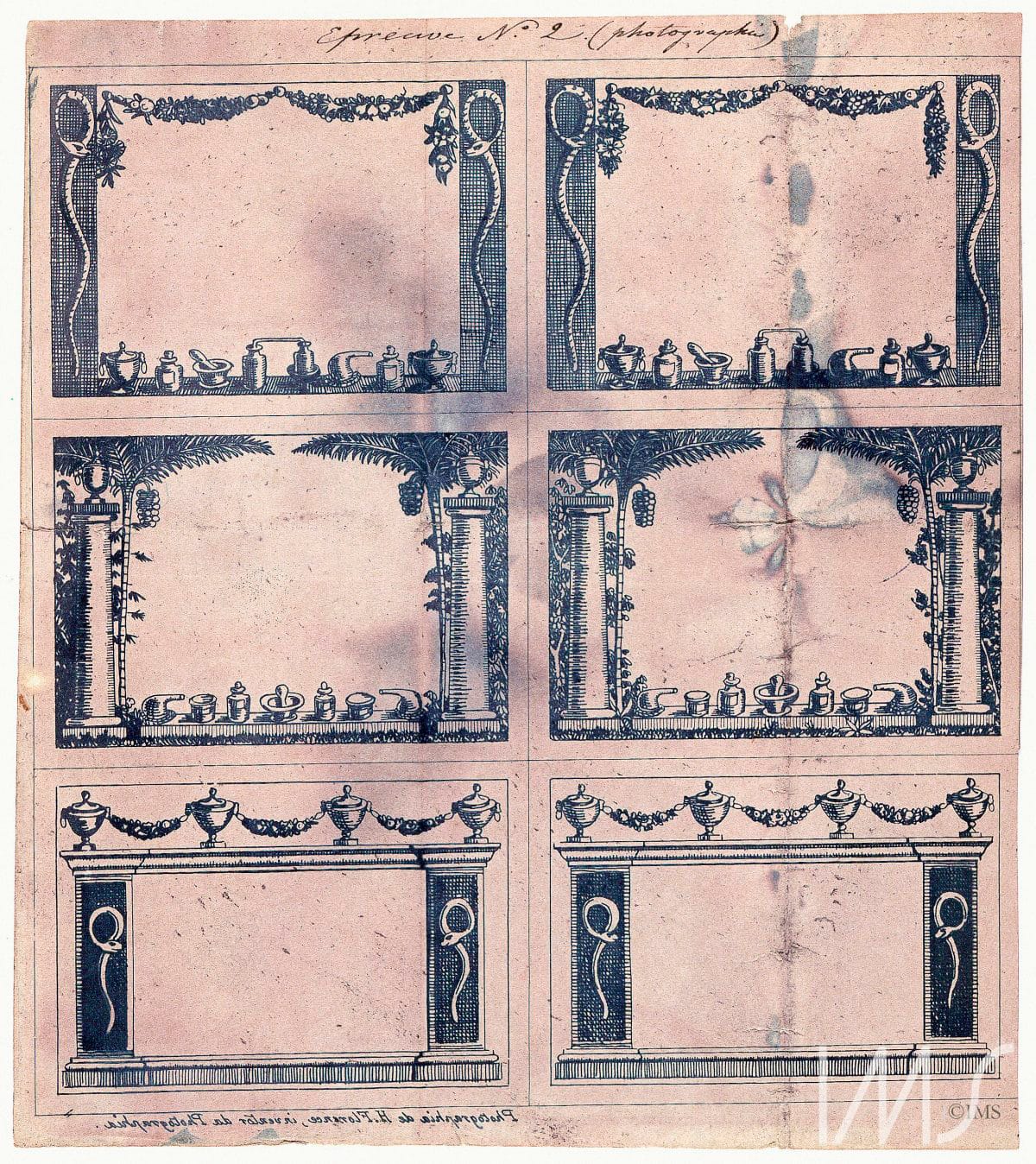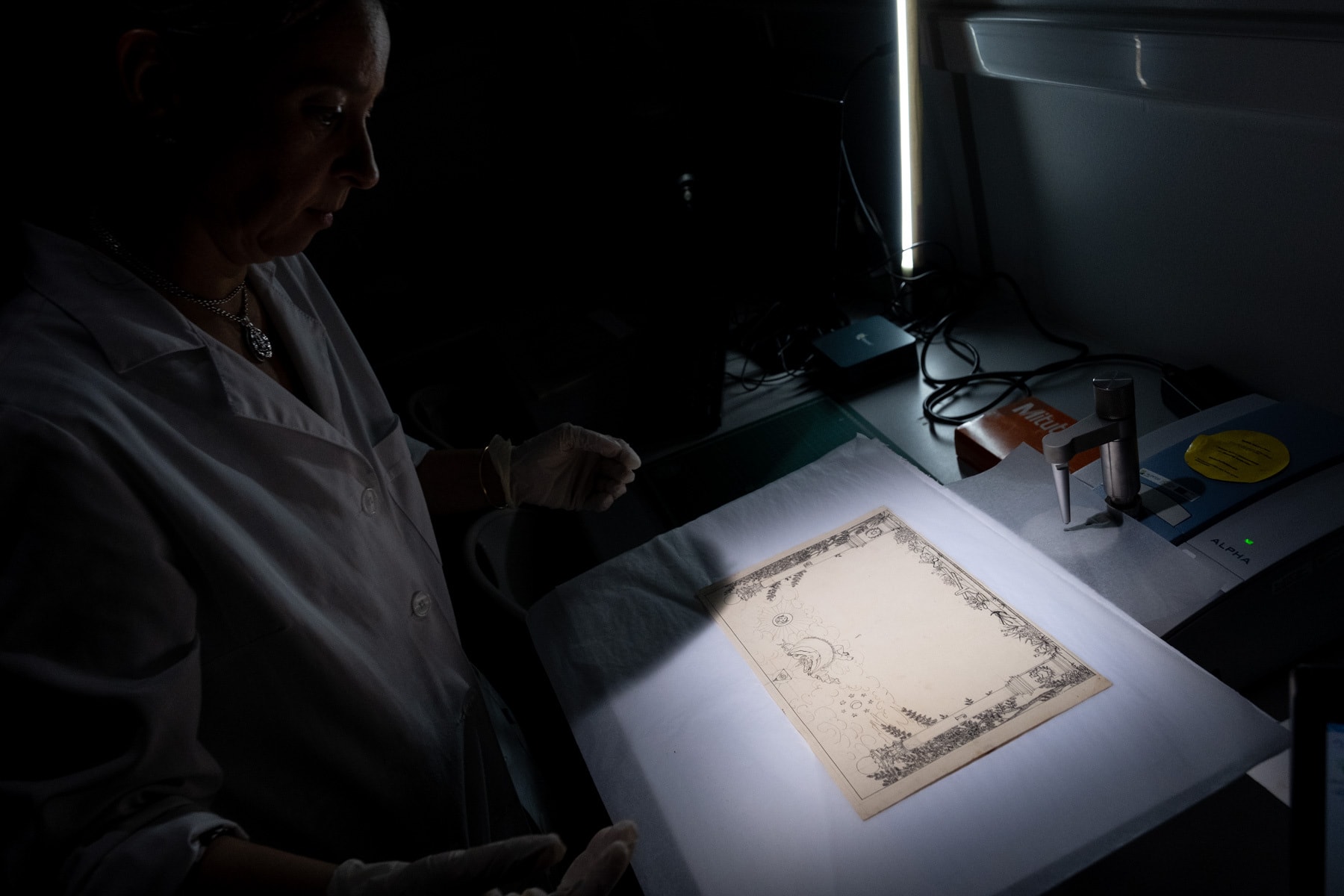
Photography (also) was invented in Brazil
Ninety years after Hercule Florence’s photographic experiments, researchers gathered in a seminar to discuss the achievements of the Franco-Brazilian, the only representative from the Americas in the pantheon of pioneering inventors of photography. In an interview, Professor and photographer Boris Kossoy, the first to study Florence’s photographic processes in depth, reflects on his legacy.
By Miguel Vilela
First, the three photographic copies and the matrix drawing produced in the early 1830s were visually examined. Then, a stereomicroscope was used to explore the details of the particles between the paper fibers. Next, the images were analyzed using infrared spectroscopy, which revealed the nature and density of the molecules that compose them. Subsequently, they were examined using three different techniques of X-ray fluorescence spectroscopy, which detected the presence of gold and silver. Finally, a powerful scanning electron microscope magnified the images to a nanometer scale, a million times smaller than a millimeter, and revealed the tiny particles of these precious metals embedded in the fibers.
This whole process, the most extensive use of these cutting-edge technologies for the examination of photographs, is part of the latest effort to demonstrate something that is still little known outside expert circles: photography was independently discovered in Brazil in 1833, six years before the announcement of the daguerreotype in France.
The studies were first presented in May by researchers Art Kaplan, from the Getty Conservation Institute in the United States and António Candeias, from the Hércules Laboratory at the University of Évora in Portugal, at the seminar “190 Years of Hercule Florence’s Photographic Experiments,” organized by the Hercule Florence Institute and the Moreira Salles Institute in the city of São Paulo. The seminar discussed Florence’s contributions to photography and the entire universe of technical images.
Born in Nice, France, in 1804, Florence arrived in Rio de Janeiro at 20. After working as a draftsman on the Russian naturalist Baron Langsdorff’s expedition to the Amazon, he settled in 1830 in São Carlos, now Campinas, a city 100 km from São Paulo.
Florence was a skilled artist; his drawings provided an essential window into 19th-century Brazil. He also had a passion for invention. In the small town, which had a population of 6,689 inhabitants in 1838, including 3,917 enslaved people, and where there was only one printing press in the province, he created his system of printing text and images, which he called “polygraphy.” In 1832, he began his experiments with solar printing and image fixation in the camera obscura.

Set of labels for pharmaceutical bottles printed by photographic processes. Moreira Salles Institute.
Despite recounting his achievements in repeated letters to authorities in France and newspaper articles, Florence never received recognition for his inventions during his lifetime, and this entire story was practically forgotten for nearly 140 years. It wasn’t until 1976 when Boris Kossoy, a photographer, art historian, and full professor at the School of Communication and Arts of the University of São Paulo, published the book “Hercule Florence, 1833: The Isolated Discovery of Photography in Brazil,” where he revealed his extensive analysis of manuscripts, documents, and images that had survived over time (mainly a Masonic diploma and pharmacy labels printed using the photographic method). At Kossoy’s request, the Rochester Institute of Technology in the United States replicated Florence’s experiments and confirmed the chemical viability of the formulas he described. The professor also demonstrated that Florence used the word “Fotografia” (Photographie in french) to describe his invention in 1834, five years before the Englishman Sir John Herschel, internationally acclaimed as the inventor of the term.
Since then, other researchers have dedicated themselves to demonstrating his experiments to place Florence in the pantheon of inventors of photography, making him the only representative from the Americas alongside Frenchmen like Niépce, Daguerre, and Bayard, as well as Englishmen like Wedgwood, Talbot, and Herschel, among many others.
In this email interview translated into Spanish, Professor Boris Kossoy recounts his historiographic work, culminating in last month’s seminar. In addition to the meticulous analysis carried out on these pharmacy labels and Masonic diplomas, the meeting allowed researchers to showcase the various works based on Florence’s oeuvre: reconstructed cameras based on his instructions, reflections on his inventive spirit, his contributions to Brazilian pictography, and contemporary artists inspired by him.
Masonic diploma printed by photographic processes. Hercule Florence Institute.
Drawing possibly used as a matrix for photographic prints of Masonic diplomas. Hercule Florence Institute.
“The invention of photography had multiple inventors, and wherever a researcher found themselves, they could have conducted experiments with the camera obscura and ‘printed’ drawings and writings ‘by the action of light’ on papers sensitized with silver nitrate, silver chloride, gold chloride, and other chemical preparations. That happened in England with Fox Talbot, France with Niépce, Daguerre, and Bayard, and in Brazil with Hercule Florence.”
Have there been any special moments of astonishment during the 51 years that I have been researching Hercule Florence’s work? Did you discover any documents or records that convinced you of his importance?
I had several moments of astonishment throughout the historical and technical confirmation process of Florence’s experiments, especially in the 1970s. The deeper I delved into this research, the more excitement I felt in uncovering new facts about photography’s invention. Other unique moments I could mention include presenting texts and international lectures at symposia and conferences in the United States, Europe, and Latin America, the recognition by the French government, the editions of my book Hercule Florence, The Isolated Discovery of Photography in Brazil in various languages, among other forms of dissemination. Lastly, my greatest astonishment was doing justice to Hercule Florence, the author of a photography invention that remained in obscurity for about 140 years, without scientific recognition and observed with distrust or considered of lesser importance by many. However, it is necessary to acknowledge that the facts and characters of photography’s history in “peripheral spaces” had not yet been the subject of systematic and in-depth studies by local researchers. In the 1970s, these studies practically did not exist. Everything was still waiting to be investigated. In Latin America, many researchers have gradually dedicated themselves to rescuing the photographic past of their countries since that decade.
You mentioned in the seminar that the fact that Florence was in Brazil, living in a city with just over 6,000 inhabitants, in a province with only one printing press, influenced his motivations to invent photography that his European compatriots did not have. Could you expand on that?
The realization of the difficulties in printing in the small Vila de São Carlos, as well as throughout the province of São Paulo and Brazil, stimulated Florence to seek a simple and economical system of graphic printing, which led him to invent the polygraphy, a process he developed starting in 1830. Two years later, although the process was still in a primitive stage, he could already apply it to printing texts and drawings. Florence immediately made his services available to the public and, at the same time, continued to refine the process for many years. The idea of photography came to him shortly after that. The lack of printing possibilities in his environment motivated Florence to explore the nature of photography and apply it to graphic arts to obtain serial copies of drawings and writings from a matrix.
Years before Daguerre’s discovery was announced, Florence was already using his photographic process practically to obtain serial “prints” of various objects, such as Masonic diplomas, labels for pharmaceutical products, and labels for other commercial activities, demonstrating the European spirit of his time by associating the concept of art and industry. The genius of the different researchers Niépce, Daguerre, Fox Talbot, Bayard, and Florence lay precisely in the fortunate combination of previous discoveries, and this knowledge could be applied more or less efficiently by any researcher, regardless of where they were. Like other scientific and technical discoveries, photography did not escape this rule: it had multiple parentages.

Drawing of Apiacás Indians in the Arinos River, Mato Grosso State, 1828. Hercule Florence Institute.
Landscape drawing in Cocais (today Nossa Senhora do Livramento, Brazil). Hercule Florence Institute
Drawing of woman and child Mandurucus of the Tapajós River, Brazil, 1828.
The seminar mentioned that there is still much to discover about Hercule Florence’s work. Do you have any curiosities that have not yet been answered?
Florence’s legacy extends to his research in different areas of knowledge. Photography, printing processes, and graphic arts have been the subject of specific studies. Similarly, his iconographic work, in all its breadth, carried out during the Langsdorff Expedition between 1825 and 1829 in the interior of Brazil, as well as his drawings, portraits, and paintings, offer a vast field of research in various areas of science and the arts.
Regarding photography, the abundant documentary material that has survived over time was essential for our historical and technical confirmation of his pioneering experiments in the Americas, contemporary with those in Europe. These documents, preserved by the descendants of the inventor, especially by Cyrillo Hercules Florence and Arnaldo Machado Florence, were decisive for the recovery of this history. I had the privilege of collaborating with them in consulting their archives to carry out this research in the 1970s. It is unlikely, but not impossible that other original documents could still be discovered in some archive.
What is the importance of continuing to study Florence’s experiences with photography? What can young photographers learn from him?
The 19th century was prolific in inventions such as the electric lamp, the steam locomotive, and later the electric one, the telegraph, the telephone, photography, cinema, and lithography, among many others. These inventions contributed to humanity’s scientific, technical, economic, and social progress.
I believe that studying Florence’s work, not only about photography but also his other achievements as an artist and inventor, is fundamental because it is an invention made in this country. Young people need to know the facts about Campinas and the context of that time to understand the importance of his work. The scope of his pioneering experiences has received due recognition at the international level.
Photography had various inventors, and as mentioned earlier, wherever an investigator was, they could have conducted experiments with the camera obscura and “print” drawings and writings “through the action of light” on papers sensitized with silver nitrate, silver chloride, gold chloride, and other chemical preparations. That happened in England with Fox Talbot, in France with Niépce, Daguerre, and Bayard, and in Brazil with Hercule Florence.


